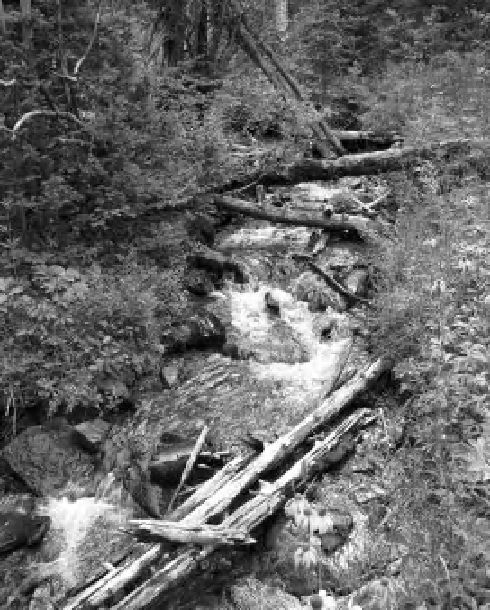Geoscience Reference
In-Depth Information
A
B
Figure 5-15.
High-energy stream l ows across a
bouldery bed l anked by shoreline hydrophytic
vegetation. Baker Creek, Culebra Range of the Sangre
de Cristo Mountains, Colorado, United States. Photo by
J.S. Aber.
Figure 5-16.
High-energy coast at Point Pinos, Pacii c
Grove, California, United States. A. Overview of waves
pounding against granite headland. B. Vertical shot of
waves swirling around granite knobs and loose
boulders. Field of view
shells, brachiopods, etc. As with clastic sedi-
ment, deposition is according to sediment
size and water energy (Fig. 5-18; see Color
Plate 2-5A).
• Chemical precipitates include various
soluble salts such as halite, gypsum and
mirabilite (Fig. 5-19), as well as less soluble
carbonates
-
calcite, aragonite and dolomite.
The precipitation of these minerals depends
on water chemistry as well as temperature,
Eh and pH, and is often mediated by
micro-organisms.
• Consolidated, rocky structures constructed
by organic activity of corals (Fig. 5-20), algae
(see Fig. 9-1), and other reef-building organ-
isms. These are associated mostly with
shallow, tropical or subtropical marine envi-
ronments in which terrigenous sediment is
scarce to absent (Fig. 5-21).
∼
40 m across. Kite airphotos by
S.W. Aber and J.S. Aber.
5.6 Summary
Soil is the complex interface between the solid
continental crust below and the atmosphere,
hydrosphere and biosphere above. Wetland
soils, known as hydric soils, were “formed under
conditions of saturation, l ooding or ponding
long enough during the growing season to
develop anaerobic conditions in the upper part”
(Natural Resources Conservation Service 2010a).
Three factors are key attributes of wetland
soils
-
saturation, reduction, and redoximorphic
features; when a dominant portion of the soil
exhibits all three factors it is classii ed as a
hydric soil.








